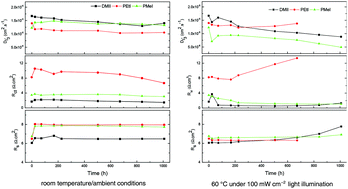New iodide-based amino acid molecules for more sustainable electrolytes in dye-sensitized solar cells
Abstract
The electrolyte is the second key component governing at once the power conversion performances and the stability of dye-sensitized solar cells. Towards the integration of more sustainable materials, we have focused on the replacement of the major constituent of the electrolyte, namely the 1,3-di-alkyl imidazolium iodide. We synthesized two new iodide molecules derived from the natural amino acid L-proline: (S)-2-(methoxycarbonyl)-1,1-dimethylpyrrolidinium iodide (PMeI) and (S)-2-(ethoxycarbonyl)-1,1-ethylpyrrolidinium iodide (PEtI). In combination with the C106 polypyridyl ruthenium(+II) sensitizer, power conversion efficiencies of 7.1% for PMeI and 6.5% for PEtI were obtained under standard Air Mass 1.5G conditions in conjunction with the low-volatile 3-methoxypropionitrile-based solvent. The relationships between these iodide molecules with the power conversion efficiencies and the interfacial charge transfer processes are herein discussed, and the new iodide molecules are systematically compared to the best standard 1,3-di-methylimidazolium iodide.



 Please wait while we load your content...
Please wait while we load your content...